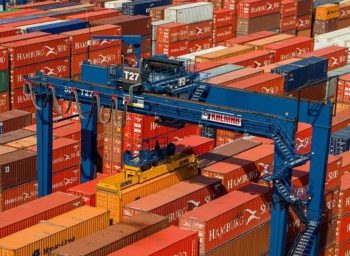Container terminal operators are facing higher risks than at any time in the industry’s history, according to a new report.
The report titled Container Terminals: Paths to Profitability suggests future investment by operators and investors will need to be more carefully considered than ever before.
The 221-page report by industry veterans Remco Stenvert and Andrew Penfold says many of the risks the industry faces are “beyond the control of operators”.
“The container port and terminal business faces greater uncertainties now than at any time since the container revolution started in the late 1970s.
“These represent systemic and intrinsic risks that could dramatically impact the outlook for port demand, profitability and investment in the next 10 years.
“All investments need to take a clear view on these risks, the days when expanding container demand could be relied upon to save marginal projects have passed,” the authors write.
The study outlines a range of external factors – the retreat of globalisation in the face of rising protectionism; the growing financial instability since 2009, with most growth since the financial crisis funded by mounting levels of debt; a structural change in the nature of demand with many developed economies now effectively reaching peak container throughput; the challenge of near-sourcing strategies; the technological challenges posed by blockchain and 3D printing; and mounting environmental – that port operators have no control over, but yet need to take into account when planning new projects.
But there is also a long list of factors internal to the shipping and terminal industry with which many are already acquainted – shipping overcapacity and under-utilisation; alliance instability, which increases in terms of risk as volume growth slows; shipping line terminal investment, which is increasingly in the minds of terminal operators independent of carrier involvement; the pressure of ever large vessel sizes; terminal overcapacity in some regions; and finally the potential for the industry to be disrupted by new operators altogether.
“The world is changing and the impact on the container port sector remains unclear. As the major new traders and logistics companies such as Amazon and Alibaba increase their market presence, there will be clear pressures for them to invest vertically in the transport chain.
“This may well see increased potential for joint ventures but could also see increased competition for investment in an uncertain market,” it says.
The good news, however, is that even under the worst cases scenario envisioned by the authors, between now and 2030 there will be some growth for the market.
If the threat of trade wars and protectionism dissipates, and the global economy enjoys a period of stable growth, the report predicts world port throughput of 1.37bn teu in 2025, 35.4% over last year, when global volumes edged past the 1bn teu mark for the first time, and further growing to 1.7bn teu by 2030.
A less-optimistic scenario imagines nations locked in a spiral of introducing retaliatory protectionist measures as divisions over trade deepen and container volumes take a hit, and would see world container throughput hit 1.29bn teu un 2025 and 1.53bn in 2030.
“This is a considerably slower demand growth profile and reflects the impact of protectionist pressures in the container sector,” the report says.
But there is also the very real risk of a cyclical downturn, which would mean cumulative growth of under 20% between now and 2025, and result in a global throughput of 1.22bn teu in that year and 1.5bn teu in 2030.
“Should another downturn be recorded, the scope for a rapid recovery will be more limited. In the current market there is much less scope for demand stimulation with interest rates already at very low levels and government indebtedness at such high levels that fiscal stimulus will be difficult to achieve.
“The actual implications of this uncertainty are difficult to forecast but, in overall terms, there is scope for an absolute reduction in demand over 2019-2021. The forecasts here developed could significantly understate the downside risk of this scenario,” it says.
Source: Loadstar
